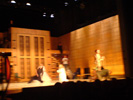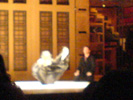A lot of positive things can be heard about the performances of Sidi Larbi Cherkaoui, but for myself I hadn’t had the chance to see one of his performances until saturday .. It was absolutly worth it and answering the already risen expectations.
This year he sets off with a large ensemble of over twenty performers and live musicians to work on a myth that writes itself during the process, and is being called thus.
Sidi Larbi works closely with Patricia Bovi, a specialist in ancient music who traces the ability to be an oracle back to traumatic experience. And so a purgatory is created, an ecumenical waiting room between the past and the present, East and West, where Catholic song calls up pre-Catholic figures and Damien Jalet, as a kind of Dracula, hunts for the shadow that influences reality retrospectively.link
He had been invited to the HAU in Berlin during the last three days with his newest piece ‘Myth’, which in the accompanying handout of the show also could provoke fears of a scary and overload interpretation:
… Katholische Gesänge rufen vorkatholische Gestalten wach, Schatten verfolgen die menschlichen Wesen und produzieren aussergewöhnliche schöne und brilliante, bald aber auch rebellierende Tanzszenen ….
Inspiriert von westlichen Mythen und der Zeichensprache japanischer Mangas entsteht eine Bilderflut, die von wundervoller alter, vor allem italienischer Musik des Ensembles Micrologus begleitet wird.
But the ensemble – the dancers, as well as the theater people and the music ensemble – provided a superb and positive surprise. Not only are they masters in their subject, they also were carefully chosen for their parts and each of them was an integrated actors of the piece. Almost never the impression arose that any of the scenes was just a filler (like some other dance-theater-performances may produce), instead each moment, movement and action on the stage added to the whole and created a fascinating, in parts also humorous performance.
The fear it could be a pure raging down the accumulation of the handout’s list as a work through and mix of all kinds of identity issues emerging from a globalization cocktail mix was in vain. Indeed it played through all the thematic points around multiculturalism, but it was an exquisite mixture based on multiplicity and simultaneity, on associative threads, with no fear of occurring ambiguities:
| It was all there: the catholic suppression of any feared emotional lust, the rationalization of the same belief, which just changes the dark (side) animal, which can be admitted, the sublimation, the turn out into fights, even the coquette and the exclusion/fight/love with her counterpart, attraction and ambivalence .. up to the lived inbetween of the transvestite: ‘.. and you, you are dressed up, but nowhere to go ..’ he/she addresses the mirror. |  |
| The myths and mystic images are played out in a big row of variations, calling up the hidden darkness they have to cover – And these create humorous scenes, as well as impressing and brilliant performance and dance scenes. It is all about the shadows cast by a certain movement, steeming from emotion or a physical one. The forced expressions are translated by the dancers into a convincing logic, a movement evolving from pushes and evasion and the wide range of transitional aspects of the inbetween. |
 |
‘Only the sun has never seen her shadow’ .. is one of the central sentences and Sidi Larbi Cherkaoui described this theme as the inspiring motor and working method for this piece:
reality? If our reality were actually the mirror-image of the shadow, which in its turn is the real ‘I’?…
A second major thread is emerging from his interest and research into the theme of traumatic events, and which traces this leaves in the bodily expressions: “The sense of shadow led me to ‘gothic’ people, and to the source of them – Gothic – as well as to the links between Gothic and depression and melancholy, then ending up at ‘trauma’ again.” he states in the lengthy interview on ImPulsTanz, and continues …
has appeared in its place.’…
(interview)
